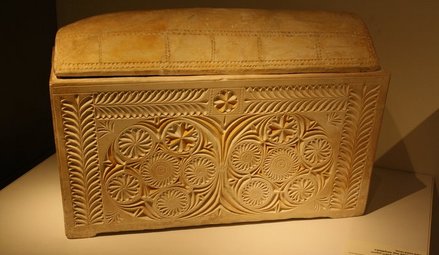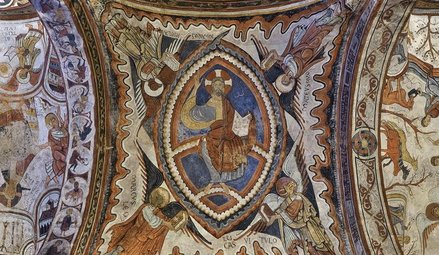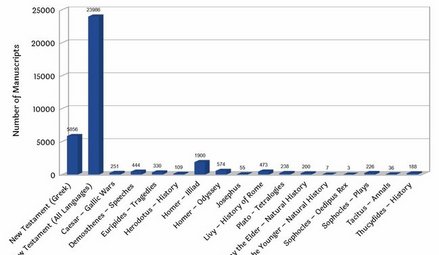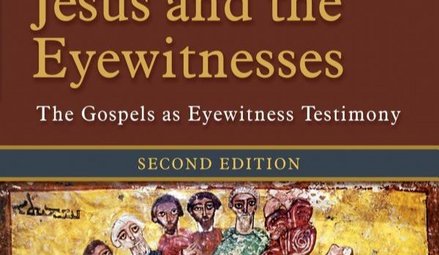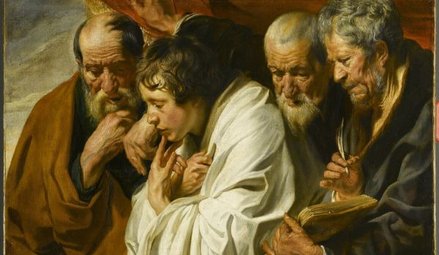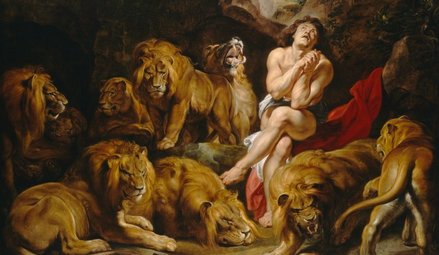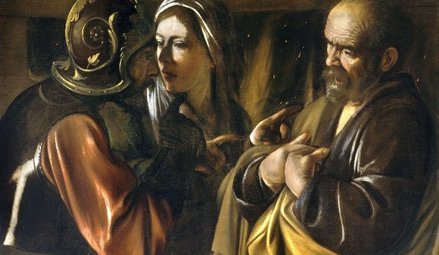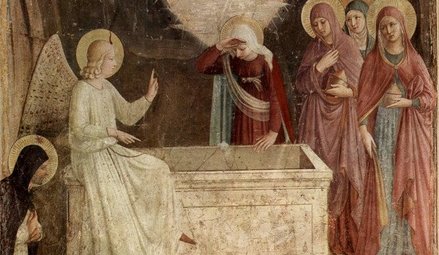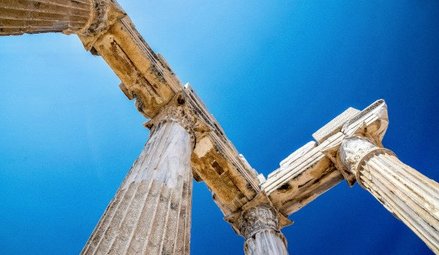- By theme
- Jesus
- The many proofs of Christ’s resurrection
- Saint Thomas Aquinas: God gave all the divine proofs we needed to believe
- The surpassing power of Christ's word
- Lewis’s trilemma: a proof of Jesus’s divinity
- God saves: the power of the holy name of Jesus
- Jesus spoke and acted as God's equal
- Jesus' divinity is actually implied in the Koran
- Jesus came at the perfect time of history
- Rabbinical sources testify to Jesus' miracles
- Mary
- The Church
- The Bible
- An enduring prophecy and a series of miraculous events preventing the reconstruction of the Temple
- The authors of the Gospels were either eyewitnesses or close contacts of those eyewitnesses
- Onomastics support the historical reliability of the Gospels
- The New Testament was not altered
- The New Testament is the best-attested manuscript of Antiquity
- The Gospels were written too early after the facts to be legends
- Archaeological finds confirm the reliability of the New Testament
- The criterion of embarrassment proves that the Gospels tell the truth
- The dissimilarity criterion strengthens the case for the historical reliability of the Gospels
- 84 details in Acts verified by historical and archaeological sources
- The unique prophecies that announced the Messiah
- The time of the coming of the Messiah was accurately prophesied
- The prophet Isaiah's ultra accurate description of the Messiah's sufferings
- Daniel's "Son of Man" is a portrait of Christ
- The Apostles
- Saint Peter, prince of the apostles
- Saint John the Apostle: an Evangelist and Theologian who deserves to be better known (d. 100)
- Saint Matthew, apostle, evangelist and martyr (d. 61)
- James the Just, “brother” of the Lord, apostle and martyr (d. 62 AD)
- Saint Matthias replaces Judas as an apostle (d. 63)
- The martyrs
- The protomartyr Saint Stephen (d. 31)
- Polycarp, bishop of Smyrna, disciple of John and martyr (d. 155)
- Justin Martyr: philosopher and apologist (d.165)
- Saint Blandina and the Martyrs of Lyon: the fortitude of faith (177 AD)
- Saint Agatha stops a volcano from destroying the city of Catania (d. 251)
- Saint Lucy of Syracuse, virgin and martyr for Christ (d. 304)
- Saint Boniface propagates Christianity in Germany (d. 754)
- Thomas More: “The king’s good servant, but God’s first”
- The martyrdom of Paul Miki and his companions (d. 1597)
- The martyrs of Angers and Avrillé (1794)
- The Martyrs of Compiègne (1794)
- The Vietnamese martyrs Father Andrew Dung-Lac and his 116 companions (17th-19th centuries)
- He braved torture to atone for his apostasy (d. 1818)
- Blaise Marmoiton: the epic journey of a missionary to New Caledonia (d. 1847)
- The Uganda martyrs: a recurring pattern in the persecution of Christians (1885)
- José Luis Sanchez del Rio, martyred at age 14 for Christ the King (d. 1928)
- Saint Maximilian Kolbe, Knight of the Immaculate (d. 1941)
- The monks
- The Desert Fathers (3rd century)
- Saint Anthony of the Desert, a father of monasticism (d. 356)
- Saint Benedict, father of Western monasticism (d. 550)
- Saint Bruno the Carthusian (d.1101): the miracle of a hidden life
- Blessed Angelo Agostini Mazzinghi: the Carmelite with flowers pouring from his mouth (d. 1438)
- Monk Abel of Valaam's accurate prophecies about Russia (d. 1841)
- The more than 33,000 miracles of Saint Charbel Maklouf (d. 1898)
- Saint Pio of Pietrelcina (d. 1968): How God worked wonders through "a poor brother who prays"
- The surprising death of Father Emmanuel de Floris (d. 1992)
- The prophecies of Saint Paisios of Mount Athos (d. 1994)
- The saints
- Saints Anne and Joachim, parents of the Virgin Mary (19 BC)
- Saint Nazarius, apostle and martyr (d. 68 or 70)
- Ignatius of Antioch: successor of the apostles and witness to the Gospel (d. 117)
- Saint Gregory the Miracle-Worker (d. 270)
- Saint Martin of Tours: patron saint of France, father of monasticism in Gaul, and the first great leader of Western monasticism (d. 397)
- Saint Augustine of Canterbury evangelises England (d. 604)
- Saint Lupus, the bishop who saved his city from the Huns (d. 623)
- Saint Rainerius of Pisa: from musician to merchant to saint (d. 1160)
- Saint Dominic of Guzman (d.1221): an athlete of the faith
- Saint Francis, the poor man of Assisi (d. 1226)
- Saint Anthony of Padua: "everyone’s saint"
- Saint Rose of Viterbo or How prayer can transform the world (d. 1252)
- Saint Simon Stock receives the scapular of Mount Carmel from the hands of the Virgin Mary
- The unusual boat of Saint Basil of Ryazan
- Saint Agnes of Montepulciano's complete God-confidence (d. 1317)
- The extraordinary conversion of Michelina of Pesaro
- Saint Peter Thomas (d. 1366): a steadfast trust in the Virgin Mary
- Saint Rita of Cascia: hoping against all hope
- Saint Catherine of Genoa and the Fire of God's love (d. 1510)
- Saint Anthony Mary Zaccaria, physician of bodies and souls (d. 1539)
- Saint Ignatius of Loyola (d. 1556): "For the greater glory of God"
- Brother Alphonsus Rodríguez, SJ: the "holy porter" (d. 1617)
- Martin de Porres returns to speed up his beatification (d. 1639)
- Virginia Centurione Bracelli: When God is the only goal, all difficulties are overcome (d.1651)
- Saint Marie of the Incarnation, "the Teresa of New France" (d.1672)
- St. Francis di Girolamo's gift of reading hearts and souls (d. 1716)
- Rosa Venerini: moving in the ocean of the Will of God (d. 1728)
- Saint Jeanne-Antide Thouret: heroic perseverance and courage (d. 1826)
- Seraphim of Sarov (1759-1833): the purpose of the Christian life is to acquire the Holy Spirit
- Camille de Soyécourt, filled with divine fortitude (d. 1849)
- Bernadette Soubirous, the shepherdess who saw the Virgin Mary (1858)
- Saint John Vianney (d. 1859): the global fame of a humble village priest
- Gabriel of Our Lady of Sorrows, the "Gardener of the Blessed Virgin" (d. 1862)
- Father Gerin, the holy priest of Grenoble (1863)
- Blessed Francisco Palau y Quer: a lover of the Church (d. 1872)
- Saints Louis and Zelie Martin, the parents of Saint Therese of Lisieux (d. 1894 and 1877)
- The supernatural maturity of Francisco Marto, “contemplative consoler of God” (d. 1919)
- Saint Faustina, apostle of the Divine Mercy (d. 1938)
- Brother Marcel Van (d.19659): a "star has risen in the East"
- Doctors
- The mystics
- Lutgardis of Tongeren and the devotion to the Sacred Heart
- Saint Angela of Foligno (d. 1309) and "Lady Poverty"
- Saint John of the Cross: mystic, reformer, poet, and universal psychologist (+1591)
- Blessed Anne of Jesus: a Carmelite nun with mystical gifts (d.1621)
- Catherine Daniélou: a mystical bride of Christ in Brittany
- Saint Margaret Mary sees the "Heart that so loved mankind"
- Jesus makes Maria Droste zu Vischering the messenger of his Divine Heart (d. 1899)
- Mother Yvonne-Aimée of Jesus' predictions concerning the Second World War (1922)
- Sister Josefa Menendez, apostle of divine mercy (d. 1923)
- Edith Royer (d. 1924) and the Sacred Heart Basilica of Montmartre
- Rozalia Celak, a mystic with a very special mission (d. 1944)
- Visionaries
- Saint Perpetua delivers her brother from Purgatory (203)
- María de Jesús de Ágreda, abbess and friend of the King of Spain
- Discovery of the Virgin Mary's house in Ephesus (1891)
- Sister Benigna Consolata: the "Little Secretary of Merciful Love" (d. 1916)
- Maria Valtorta's visions match data from the Israel Meteorological Service (1943)
- Berthe Petit's prophecies about the two world wars (d. 1943)
- Maria Valtorta saw only one pyramid at Giza in her visions... and she was right! (1944)
- The location of Saint Peter's village seen in a vision before its archaeological discovery (1945)
- The 700 extraordinary visions of the Gospel received by Maria Valtorta (d. 1961)
- The amazing geological accuracy of Maria Valtorta's writings (d. 1961)
- Maria Valtorta's astronomic observations consistent with her dating system
- Discovery of an ancient princely house in Jerusalem, previously revealed to a mystic (d. 1961)
- Mariette Kerbage, the seer of Aleppo (1982)
- The 20,000 icons of Mariette Kerbage (2002)
- The popes
- The great witnesses of the faith
- Saint Augustine's conversion: "Why not this very hour make an end to my uncleanness?" (386)
- Thomas Cajetan (d. 1534): a life in service of the truth
- Madame Acarie, "the servant of the servants of God" (d. 1618)
- Blaise Pascal (d.1662): Biblical prophecies are evidence
- Madame Élisabeth and the sweet smell of virtue (d. 1794)
- Jacinta, 10, offers her suffering to save souls from hell (d. 1920)
- Father Jean-Édouard Lamy: "another Curé of Ars" (d. 1931)
- Christian civilisation
- The depth of Christian spirituality
- John of the Cross' Path to perfect union with God based on his own experience
- The dogma of the Trinity: an increasingly better understood truth
- The incoherent arguments against Christianity
- The "New Pentecost": modern day, spectacular outpouring of the Holy Spirit
- The Christian faith explains the diversity of religions
- Cardinal Pierre de Bérulle (d.1629) on the mystery of the Incarnation
- Christ's interventions in history
- Marian apparitions and interventions
- The Life-giving Font of Constantinople
- Apparition of Our Lady of La Treille in northern France: prophecy and healings (600)
- Our Lady of Virtues saves the city of Rennes in Bretagne (1357)
- Mary stops the plague epidemic at Mount Berico (1426)
- Our Lady of Miracles heals a paralytic in Saronno (1460)
- Cotignac: the first apparitions of the Modern Era (1519)
- Savona: supernatural origin of the devotion to Our Lady of Mercy (1536)
- The Virgin Mary delivers besieged Christians in Cusco, Peru
- The victory of Lepanto and the feast of Our Lady of the Rosary (1571)
- The apparitions to Brother Fiacre (1637)
- The “aldermen's vow”, or the Marian devotion of the people of Lyon (1643)
- Our Lady of Nazareth in Plancoët, Brittany (1644)
- Our Lady of Laghet (1652)
- Saint Joseph’s apparitions in Cotignac, France (1660)
- Heaven confides in a shepherdess of Le Laus (1664-1718)
- Zeitoun, a two-year miracle (1968-1970)
- The Holy Name of Mary and the major victory of Vienna (1683)
- Heaven and earth meet in Colombia: the Las Lajas shrine (1754)
- The five Marian apparitions that traced an "M" over France, and its new pilgrimage route
- A series of Marian apparitions and prophetic messages in Ukraine since the 19th century (1806)
- "Consecrate your parish to the Immaculate Heart of Mary" (1836)
- At La Salette, Mary wept in front of the shepherds (1846)
- Our Lady of Champion, Wisconsin: the first and only approved apparition of Mary in the US (1859)
- Gietrzwald apparitions: heavenly help to a persecuted minority
- The silent apparition of Knock Mhuire in Ireland (1879)
- Mary "Abandoned Mother" appears in a working-class district of Lyon, France (1882)
- The thirty-three apparitions of the Virgin Mary in Beauraing (1932)
- "Our Lady of the Poor" appears eight times in Banneux (1933)
- Fontanelle-Montichiari apparitions of Our Lady "Rosa Mystica" (1947)
- Mary responds to the Vows of the Polish Nation (1956)
- Zeitoun apparitions
- The Virgin Mary comes to France's rescue by appearing at L'Ile Bouchard (1947)
- Maria Esperanza Bianchini and Mary, Mary, Reconciler of Peoples and Nations (1976)
- Luz Amparo and the El Escorial apparitions
- The extraordinary apparitions of Medjugorje and their worldwide impact
- The Virgin Mary prophesied the 1994 Rwandan genocide (1981)
- Our Lady of Soufanieh's apparition and messages to Myrna Nazzour (1982)
- The Virgin Mary heals a teenager, then appears to him dozens of times (1986)
- Seuca, Romania: apparitions and pleas of the Virgin Mary, "Queen of Light" (1995)
- Angels and their manifestations
- Mont Saint-Michel: Heaven watching over France
- The revelation of the hymn Axion Estin by the Archangel Gabriel (982)
- Angels give a supernatural belt to the chaste Thomas Aquinas (1243)
- The constant presence of demons and angels in the life of St Frances of Rome (d. 1440)
- Mother Yvonne-Aimée escapes from prison with the help of an angel (1943)
- Saved by Angels: The Miracle on Highway 6 (2008)
- Exorcisms in the name of Christ
- A wave of charity unique in the world
- Saint Peter Nolasco: a life dedicated to ransoming enslaved Christians (d. 1245)
- Rita of Cascia forgives her husband's murderer (1404)
- Saint Angela Merici: Christ came to serve, not to be served (d. 1540)
- Saint John of God: a life dedicated to the care of the poor, sick and those with mental disorders (d. 1550)
- Saint Camillus de Lellis, reformer of hospital care (c. 1560)
- Blessed Alix Le Clerc, encouraged by the Virgin Mary to found schools (d. 1622)
- Saint Vincent de Paul (d. 1660), apostle of charity
- Marguerite Bourgeoys, Montreal's first teacher (d. 1700)
- Frédéric Ozanam, inventor of the Church's social doctrine (d. 1853)
- Damian of Molokai: a leper for Christ (d. 1889)
- Pier Giorgio Frassati (d.1925): heroic charity
- Saint Dulce of the Poor, the Good Angel of Bahia (d. 1992)
- Mother Teresa of Calcutta (d. 1997): an unshakeable faith
- Heidi Baker: Bringing God's love to the poor and forgotten of the world
- Amazing miracles
- The miracle of liquefaction of the blood of St. Januarius (d. 431)
- The miracles of Saint Anthony of Padua (d. 1231)
- Saint Pius V and the miracle of the Crucifix (1565)
- Saint Philip Neri calls a teenager back to life (1583)
- The resurrection of Jérôme Genin (1623)
- Saint Francis de Sales brings back to life a victim of drowning (1623)
- Saint John Bosco and the promise kept beyond the grave (1839)
- The day the sun danced at Fatima (1917)
- Pius XII and the miracle of the sun at the Vatican (1950)
- When Blessed Charles de Foucauld saved a young carpenter named Charle (2016)
- Reinhard Bonnke: 89 million conversions (d. 2019)
- Miraculous cures
- The royal touch: the divine thaumaturgic gift granted to French and English monarchs (11th-19th centuries)
- With 7,500 cases of unexplained cures, Lourdes is unique in the world (1858-today)
- Our Lady at Pellevoisin: "I am all merciful" (1876)
- Mariam, the "little thing of Jesus": a saint from East to West (d.1878)
- The miraculous healing of Marie Bailly and the conversion of Dr. Alexis Carrel (1902)
- Gemma Galgani: healed to atone for sinners' faults (d. 1903)
- The miraculous cure of Blessed Maria Giuseppina Catanea
- The extraordinary healing of Alice Benlian in the Church of the Holy Cross in Damascus (1983)
- The approved miracle for the canonization of Juan Diego Cuauhtlatoatzin (1990)
- Healed by St Charbel Makhlouf, her scars bleed each month for the benefit of unbelievers (1993)
- The miracle that led to Brother André's canonisation (1999)
- Bruce Van Natta's intestinal regrowth: an irrefutable miracle (2007)
- He had “zero” chance of living: a baby's miraculous recovery (2015)
- Manouchak, operated on by Saint Charbel (2016)
- How Maya was cured from cancer at Saint Charbel's tomb (2018)
- Preserved bodies of the saints
- Dying in the odour of sanctity
- The body of Saint Cecilia found incorrupt (d. 230)
- Saint Claudius of Besançon: a quiet leader, a calm presence, and a strong belief in the value of prayer (d. 699)
- Stanislaus Kostka's burning love for God (d. 1568)
- Saint Germaine of Pibrac: God's little Cinderella (d. 1601)
- Blessed Antonio Franco, bishop and defender of the poor (d. 1626)
- Giuseppina Faro, servant of God and of the poor (d. 1871)
- The incorrupt body of Marie-Louise Nerbollier, the visionary from Diémoz (d. 1910)
- The great exhumation of Saint Charbel (1950)
- Bilocations
- Inedias
- Levitations
- Lacrimations and miraculous images
- Saint Juan Diego's tilma (1531)
- The Rue du Bac apparitions of the Virgin Mary to St. Catherine Labouré (Paris, 1830)
- Mary weeps in Syracuse (1953)
- Teresa Musco (d.1976): salvation through the Cross
- Soufanieh: A flow of oil from an image of the Virgin Mary, and oozing of oil from the face and hands of Myrna Nazzour (1982)
- The Saidnaya icon exudes a wonderful fragrance (1988)
- Our Lady weeps in a bishop's hands (1995)
- Stigmates
- The venerable Lukarda of Oberweimar shares her spiritual riches with her convent (d. 1309)
- Florida Cevoli: a heart engraved with the cross (d. 1767)
- Blessed Maria Grazia Tarallo, mystic and stigmatist (d. 1912)
- Saint Padre Pio: crucified by Love (1918)
- Elena Aiello: "a Eucharistic soul"
- A Holy Triduum with a Syrian mystic, witnessing the sufferings of Christ (1987)
- A Holy Thursday in Soufanieh (2004)
- Eucharistic miracles
- Lanciano: the first and possibly the greatest Eucharistic miracle (750)
- A host came to her: 11-year-old Imelda received Communion and died in ecstasy (1333)
- Faverney's hosts miraculously saved from fire
- A tsunami recedes before the Blessed Sacrament (1906)
- Buenos Aires miraculous host sent to forensic lab, found to be heart muscle (1996)
- Relics
- The Veil of Veronica, known as the Manoppello Image
- For centuries, the Shroud of Turin was the only negative image in the world
- The Holy Tunic of Argenteuil's fascinating history
- Saint Louis (d. 1270) and the relics of the Passion
- The miraculous rescue of the Shroud of Turin (1997)
- A comparative study of the blood present in Christ's relics
- Jews discover the Messiah
- Francis Xavier Samson Libermann, Jewish convert to Catholicism (1824)
- Our Lady of the Miraculous Medal and the conversion of Alphonse Ratisbonne (1842)
- Max Jacob: a liberal gay Jewish artist converts to Catholicism (1909)
- Edith Stein - Saint Benedicta of the Cross: "A daughter of Israel who, during the Nazi persecutions, remained united with faith and love to the Crucified Lord, Jesus Christ, as a Catholic, and to her people as a Jew"
- Patrick Elcabache: a Jew discovers the Messiah after his mother is miraculously cured in the name of Jesus
- Olivier's conversion story: from Pesach to the Christian Easter (2000)
- Cardinal Aron Jean-Marie Lustiger (d. 2007): Chosen by God
- Muslim conversions
- He met Jesus while looking for Muhammad (1990)
- Selma's journey to baptism (1996)
- Soumia, converted to Jesus as she hears Christmas carols (2003)
- How Aïsha, a Muslim convert, found Jesus (2004)
- Amir chooses Christ, at the risk of becoming homeless (2004)
- Souad Brahimi: brought to Jesus by Mary (2012)
- Pursued by God: Khadija's story (2023)
- Buddhist conversions
- Atheist conversions
- The conversion of an executioner during the Terror (1830)
- God woos a poet's heart: the story of Paul Claudel's conversion (1886)
- From agnostic to Catholic Trappist monk (1909)
- Dazzled by God: Madeleine Delbrêl's story (1924)
- C.S. Lewis, the reluctant convert (1931)
- The day André Frossard met Christ in Paris (1935)
- MC Solaar's rapper converts after experiencing Jesus' pains on the cross
- Father Sébastien Brière, converted at Medjugorje (2003)
- Franca Sozzani, the "Pope of fashion" who wanted to meet the Pope (2016)
- Nelly Gillant: from Reiki Master to Disciple of Christ (2018)
- Testimonies of encounters with Christ
- Near-death experiences (NDEs) confirm Catholic doctrine on the Four Last Things
- The NDE of Saint Christina the Astonishing, a source of conversion to Christ (1170)
- Jesus audibly calls Alphonsus Liguori to follow him (1723)
- Blessed Dina Bélanger (d. 1929): loving God and letting Jesus and Mary do their job
- Gabrielle Bossis: He and I
- André Levet's conversion in prison
- Journey between heaven and hell: a "near-death experience" (1971)
- Jesus' message to Myrna Nazzour (1984)
- Alicja Lenczewska: conversations with Jesus (1985)
- Vassula Ryden and the "True Life in God" (1985)
- Nahed Mahmoud Metwalli: from persecutor to persecuted (1987)
- The Bible verse that converted a young Algerian named Elie (2000)
- Invited to the celestial court: the story of Chantal (2017)
- Providential stories
- The superhuman intuition of Saint Pachomius the Great
- Ambrose of Milan finds the bodies of the martyrs Gervasius and Protasius (386)
- Germanus of Auxerre's prophecy about Saint Genevieve's future mission, and protection of the young woman (446)
- Seven golden stars reveal the future location of the Grande Chartreuse Monastery (1132)
- The supernatural reconciliation of the Duke of Aquitaine (1134)
- Saint Zita and the miracle of the cloak (13th c.)
- Joan of Arc: "the most beautiful story in the world"
- John of Capistrano saves the Church and Europe (1456)
- A celestial music comforts Elisabetta Picenardi on her deathbed (d. 1468)
- Gury of Kazan: freed from his prison by a "great light" (1520)
- The strange adventure of Yves Nicolazic (1623)
- Julien Maunoir miraculously learns Breton (1626)
- Pierre de Keriolet: with Mary, one cannot be lost (1636)
- How Korea evangelized itself (18th century)
- A hundred years before it happened, Saint Andrew Bobola predicted that Poland would be back on the map (1819)
- The prophetic poem about John Paul II (1840)
- Don Bosco's angel dog: Grigio (1854)
- The purifying flames of Sophie-Thérèse de Soubiran La Louvière (1861)
- Thérèse of Lisieux saved countless soldiers during the Great War
- Lost for over a century, a Russian icon reappears (1930)
- In 1947, a rosary crusade liberated Austria from the Soviets (1946-1955)
- The discovery of the tomb of Saint Peter in Rome (1949)
- He should have died of hypothermia in Soviet jails (1972)
- God protects a secret agent (1975)
- Flowing lava stops at church doors (1977)
- A protective hand saved John Paul II and led to happy consequences (1981)
- Mary Undoer of Knots: Pope Francis' gift to the world (1986)
- Edmond Fricoteaux's providential discovery of the statue of Our Lady of France (1988)
- The Virgin Mary frees a Vietnamese bishop from prison (1988)
- The miracles of Saint Juliana of Nicomedia (1994)
- Global launch of "Pilgrim Virgins" was made possible by God's Providence (1996)
- The providential finding of the Mary of Nazareth International Center's future site (2000)
- Syrian Monastery shielded from danger multiple times (2011-2020)
- Jesus
- Who are we?
- Make a donation
TOUTES LES RAISONS DE CROIRE
La Bible
n°34
Judea
First century
The time of the coming of the Messiah was accurately prophesied
It is amazing to see that the time of the Messiah's coming was accurately predicted by several prophecies well known to Jews and to those living at the time of Christ. According to the patriarch Jacob, the "scepter" first had to depart from Judah (Gen 49:1); for the prophet Haggai, the Messiah would come at the time of the Second Temple; for the prophet Daniel, it would coincide with the time of the fourth kingdom "after Nebuchadnezzar" (Dan 2:39) and "Seventy Weeks" after a prophecy announcing the rebuilding of the Temple (Dan 9:24); as for the prophet Isaiah, he predicted that the "Prince of Peace" would arrive at a time when the world would have ceased to fight (cf. Is 9:5), in the "fullness of time" (Ga 4:4; Eph 1:10). Even the pagans (Tacitus, Suetonius, the Sibyl of Cumae, the Babylonian astrologers) sensed the coming of a "world-dominating" Messiah from Israel. At the time of Christ, therefore, "the people were waiting" (Lk 3:15) in a very singular way. So, when John the Baptist appeared, they all asked him: "Are you the One who is to come, or must we wait for another?" (Lk 7:19). The anticipation had become so strong in this period of history that historians have identified dozens of candidate Messiahs (cf. Vittorio Messori, Hypothèses sur Jésus, Mame, 1995, ch. 4), and Gamaliel alluded to it during his address to the Sanhedrin on behalf of the apostles (Acts 5:34-39). Lastly, even if some Jews did not recognize Christ, they nonetheless bear indirect witness to the great precision of this expectation: after the first century and the failed revolt of Bar Kochba "son of the star" (died 135) - thought to be the Messiah by Rabbi Akiva and the Jewish leaders of the time - they acknowledged in the Talmud that "all the dates calculated for the coming of the Messiah have now expired" ( Tractate Sanhedrin no. 97).
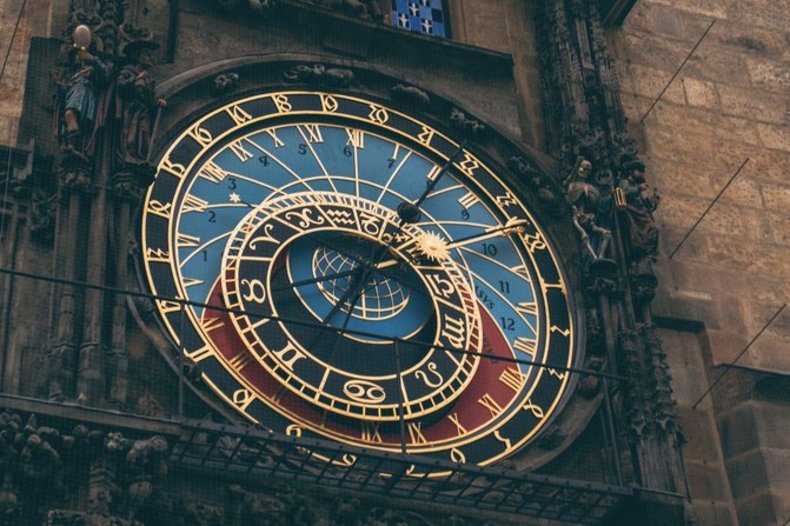
Horloge astronomique de Prague / ©Unsplash/Nikita Voloshyn
Les raisons d'y croire :
- That all the afore-mentioned prophecies were written before the time of Christ is undisputed.
- Israel's unique sense of expectation at the beginning of our era is a documented fact.
- The 70 weeks can be interpreted both in years (490 years) or days (490 days), both calculations pointing precisely to the time of Christ.
- "The time [of the Messiah's coming] was foretold by the state of the Jewish people, by the state of the Gentiles, by the state of the Temple, and by the number of years [...]. The four monarchies, the scepter taken from Judah and the seventy weeks had to arrive at the same time, and all before the second Temple was destroyed", as Blaise Pascal summed it up (Pensées, 314 and 317). Pascal also said that "the greatest proof of Jesus Christ are the prophecies" (Pensées, 316).
- The astonishing testimonies of the pagans reinforce the biblical prophecies, and the only reasonable conclusion is that the Messiah indeed came at the appointed time, as he himself proclaimed: "This is the time of fulfillment" (Mk 1:15).
Synthèse :
Unique in the history of the world, the coming of a Savior Messiah was awaited in Israel, due to numerous prophecies received by a long series of men, over many centuries.
The Messiah was especially awaited at the beginning of our era, at the time of the Virgin Mary, because certain prophecies spoke explicitly and precisely of the moment of his coming.
The Gospel testifies to the pervasiveness of this very special expectation that had seized everyone. "As the people were filled with expectation" (Lk 3:15) when John the Baptist appeared, they all asked him: "Are you the One who is to come, or must we wait for another?" (Lk 7:19). This was an absolutely unprecedented time, and this characteristic aspect of the birth of Christianity alone is enough - in the opinion of many specialists - to set it quite apart from other religions throughout history.
The expectation of the fulfillment of the times had become so strong and precise, in this particular period of history, that there were more than a hundred would-be Messiahs listed by historians. Gamaliel referred to this in his intervention on behalf of the apostles before the Sanhedrin: "But a Pharisee in the Sanhedrin named Gamaliel, a teacher of the law, respected by all the people, stood up, ordered the men to be put outside for a short time, and said to them, “Fellow Israelites, be careful what you are about to do to these men. Some time ago, Theudas appeared, claiming to be someone important, and about four hundred men joined him, but he was killed, and all those who were loyal to him were disbanded and came to nothing. After him came Judas the Galilean at the time of the census. He also drew people after him, but he too perished and all who were loyal to him were scattered. So now I tell you, have nothing to do with these men, and let them go. For if this endeavor or this activity is of human origin, it will destroy itself. But if it comes from God, you will not be able to destroy them; you may even find yourselves fighting against God."(Acts 5: 34-40).
The reason for this expectation on the part of the people is to be found in five great prophecies which pointed precisely to the time of the coming of the Messiah:
1. The first of these prophecies evoking the moment of the Messiah's coming is found in Genesis, when Jacob, born of Isaac, blesses his sons before dying: "Gather around, that I may tell you what is to happen to you in days to come" (Gen 49:1-10). And Jacob also predicted: "The scepter shall not depart from Judah, nor the rod of command from between his feet, until he comes to whom it belongs and to whom the peoples owe obedience."
This passage, which has always been understood by Israel's exegetes in a messianic sense, takes on new relevance in the Virgin's time, after Herod I was appointed king of Judea, putting an end to the Jewish Hasmonean dynasty. The Jews of Israel would henceforth be ruled by an Edomite king, the son of a Nabataean woman from an Arab tribe, and a friend of the Romans, even though he had officially converted to Judaism. Judea became a vassal province of Rome, and remained so until the destruction of Jerusalem in 70 AD.
When Octavian confirmed Herod I as king of Judea, Samaria, Idumaea and Galilee, offering him the Golan Heights and the Mediterranean coastal cities he had previously given back to Cleopatra, Jerusalem was shaken by an earthquake that killed ten thousand people. With the advent of Herod I, control of the region passed to the Romans: the messianic sign was fulfilled, as the scepter was finally taken away from Judah.
In fact, when Christ was put on trial, the Jews were correct in replying to Pilate: "We have no king but Caesar" (Jn 19:15).
2. The second most important prophecy about the time of the coming of the Messiah is found in the last book of the Old Testament, that of Daniel, which by the time of the Virgin had already been composed and read in its present form for two centuries. Chapter 2 relates Nebuchadnezzar's dream, in which the king sees a small stone shatter a large statue made of gold, silver, bronze, iron and clay. Disturbed, the king can't sleep until Daniel gives him the right interpretation: "Another kingdom shall take your place, inferior to yours, then a third kingdom, of bronze, which shall rule over the whole earth.. There shall be a fourth kingdom, strong as iron; it shall break in pieces and subdue all these others [...]. It shall be a divided kingdom… partly strong and partly fragile. [...]. In the lifetime of those kings the God of heaven will set up a kingdom that shall never be destroyed or delivered up to another people; rather, it shall break in pieces all these kingdoms and put an end to them, and it shall stand forever [...]. The great God has revealed to the king what shall be in the future; this is exactly what you dreamed, and its meaning is sure." (Dan 2:39-45).
Now, after Nebuchadnezzar came the Persians and the Medes together; then the Greeks, who dominated the whole earth with Alexander; then the Romans who, with iron, reduced all their adversaries to dust, before Israel was divided in the 1st century between the iron of Rome and the clay of Herod. Rome, then, is the so-called "fourth kingdom after Nebuchadnezzar" (Dan 2:39), in which the stone that shatters the statue is to become a great mountain that will fill the whole earth. The humble Virgin of the Lord perhaps was able to envision the modest beginnings of the Messianic reign that "will never be destroyed and will endure forever" (Dn 2:44), by meditating on the above prophecy of the small stone that becomes a mountain, as Blaise Pascal would later write: "It was foretold that Jesus Christ would be small in his beginning and that he would then grow" (Pensées, 310).
3. The third great prophecy indicating the time of Messiah's coming also comes from Daniel, who amazingly stated that there would be "70 weeks" (literally “70 septenaries”) before his arrival. This famous passage from Daniel chapter 9 prophesies as follows: "Seventy weeks are decreed for your people and for your holy city: Then transgression will stop and sin will be sealed up, guilt will be expiated, everlasting justice will be introduced, vision and prophecy ratified, and a holy of holies will be anointed" (Dan 9:24). The new world (iniquity ceasing and being atoned for, sin being "sealed up", and eternal justice reigning) will therefore come about when Christ has "received the anointing". Then the visions of the prophets themselves will come to an end. And all this was to happen after "70 weeks".
This time reference, the only one found in the Old Testament, has never been an object of much controversy among interpreters. The prophecy clearly uses the word "septenaries" (or "weeks"), i.e. "periods of seven", and are counted a priori in years; the prophecy thus points to the coming of the Messiah at the end of 490 years. But when should we start counting? According to Scripture (Dn 9:23), the counting starts "from the mention of rebuilding Jerusalem'' after the Babylonian exile. Some calculated it from Artaxerxes' decree in 458 BC, others from Nehemiah's first mission in 445, others from Cyrus' liberation of Israel in 538, some in solar years, others in lunar years. The 1st century BC scrolls discovered at Qumran show that the community living there was very attentive to the signs of the times, and that they also relied on the prophecy of the "70 weeks". They had calculated that the time of the Messiah would begin in 26 BC, and it was because of this expectation that they withdrew to the desert. There was still a small "error" of twenty years in their calculation, but, as Hugh Schonfield says, "we can see today just how much - almost to the letter - Jesus could proclaim in inaugurating his mission: 'The time is fulfilled and the kingdom of God is at hand' (Mk 1:15)."
The prophecy speaks of seventy septenaries (or seventy weeks) to be counted from an announcement of the rebuilding of the Temple, but it does not specify whether this count is to be made in years, months, days, or other. From this, the traditional interpretation has been to count years, but it's also possible to imagine that it was referring to the lunar years used in the Jewish calendar. In this case, since 490 lunar years represent 441 solar years, if we count from 445 BC, the date of Nehemiah's reconstruction of the city walls (Neh 2:3-20), we arrive at 4 BC, which is indeed the exact date of Jesus' presentation in the Temple.
But there is more: if one counts the seventy septenaries in days, it all fits together just as neatly! In fact, there are exactly 490 days between the Announcement to Zechariah and the Presentation of Jesus in the Temple, to which the prophecy refers: 6 months between the Announcement to Zechariah and the Angel's Announcement to Mary (180 days), 9 months of Mary's pregnancy (270 days) and 40 days before the Presentation in the Temple. The total is exactly 490 days!
4. A fourth prophecy is given by the prophet Haggai, who indicates that the Messiah was to come at the time of the Second Temple, and therefore not after its destruction in 70 AD. The prophet was in Jerusalem when the Second Temple was being built, and pronounced the messianic oracle that "Greater will be the glory of this house, the latter more than the former" (Hag 2:9). Yet the Second Temple no longer had the Ark of the Covenant, the Tables of the Law, the jar of manna (Ex 16:33) and Aaron's branch (cf. Heb 9:4). How, then, could the glory of the Second Temple be greater than that of the first, which was so prestigious? Simply because the Second Temple had the unsurpassed honor of being visited by the Messiah in person. Malachi confirms this vision: "And suddenly the Lord you seek will enter his Temple - and the messenger of the Covenant, behold, he is coming" (Mal 3:1), a verse that has always been understood messianically by the Jews. For example, a 12th-century scholar, Rabbi David Kimchi, refers to this verse when he says: "The Lord, the angel of the Covenant, is the Messiah" (LRC 2, p. 165). And this prophecy was indeed fulfilled, for apart from the coming of the Messiah, it is clear that there was no historical event to justify such "glory" for the Second Temple.
5. A fifth prophecy states that the Messiah will be "Prince of Peace" (Is 9:5), which has been interpreted in Jewish tradition as meaning that he will come "when the world has ceased to fight" (Talmud). And that's exactly what happened: Jesus was born during the Pax Romana, at the time of Cesar Augustus (Octovian), an unprecedented 25-year period of peace, without a single war.
Inexplicably, there was also a unique sense of expectation, around that same time, among the pagans: we have unmistakable and precise testimonies to this universal expectation of a "world dominator" who was to come from Judea.
Two of the greatest Latin historians, Tacitus and Suetonius, tell us how the Romans, too, were waiting for the century that we now call "the first after Jesus Christ".
1. Tacitus writes in Histories: "Most were convinced that it was written in the ancient books of the priests that, towards these times, the East would grow in power. And that from Judea would come the rulers of the world."
2. Likewise, in his Life of Vespasian, Suetonius writes: "Throughout the East, an idea was gaining ground: the constant and ancient opinion that it should be written in the destiny of the world that from Judea would come the dominators of the world at that time."
These two historians were writing at the end of the first century and the beginning of the second, without being able to foresee the triumph, yet to come, of the Man who would one day effectively "dominate" the Western world.
3. Virgil, for his part, quotes the oracle of the Sibyl of Cumae announcing a "marvelous child, who will bring the golden age" in the Fourth Eclogue of his Bucolics, dating the event precisely to the reign of the emperor Augustus: "Here are the last times marked by the oracle of the Sibyl of Cumae: the long series of centuries begins again. Here comes the Virgin, and the reign of Saturn. A new race descends from heaven. A newborn child under the reign of Emperor Augustus will eliminate the generation of iron and raise up a generation of gold throughout the world." The Virgin Mary, in whom the Son of God would descend, surely didn't know about this oracle, but Jesus, who was indeed born during the reign of Emperor Augustus, did indeed transform the iron of oppression into the gold of love.
4. It is astonishing to note that in many of the world's shrines (e.g. Longpont, Nogent-sous-Coucy, Chartres), the "Virgo Paritura", the "Virgin who is to give birth", was revered even before Christ.
5. Another astounding point is that it now seems scientifically established that Babylonian astrologers were also awaiting the birth of the "ruler of the world" as early as 7 BC.
In December 1603, Kepler, one of the fathers of modern astronomy, observed the bright conjunction (i.e. the alignment) of Jupiter and Saturn in the constellation Pisces. Thanks to his calculations, he established that the same phenomenon (which causes an intense, brilliant light in the starry sky) must also have occurred in 7 BC He then discovered an ancient commentary on Scripture by Rabbi Abarbanel, recalling that, according to a Jewish belief, the Messiah was to appear precisely when, in the constellation of Pisces, the light of Jupiter and Saturn would become one. But Kepler's discovery was not given much importance, because critics had not yet established with certainty that Jesus was born before the traditional date, following the error of Dionysius the Lesser.
More than two centuries later, the Danish scholar Münter discovered and deciphered a medieval Hebrew commentary on the "70 septenaries" of the Book of Daniel, indicating the belief recalled by Kepler. In 1902, the so-called "Planetary Table", now preserved in Berlin, was published: an Egyptian papyrus which accurately records the movements of the planets from 17 BC to 10 AD, and recalls that in 7 BC, the conjunction between Jupiter and Saturn had been noticed, visible in its most beautiful brilliance all over the Mediterranean.
Finally, in 1925, a description of the Sippar stellar calendar was published: a terracotta tablet with cuneiform inscriptions from the ancient city of Sippar, on the Euphrates, which was the seat of an important Babylonian school of astrology. This "calendar" shows all the celestial movements and conjunctions for the year 7 BC. Why? Because, according to Babylonian astrologers, this conjunction - observed only once every 794 years - had occurred three times in the year 7 BC: on May 29, October 1 and December 5 (which is entirely consistent with the Gospel, where the "star" appeared and reappeared - cf. Mt 2:2; 2:7; 2:9). The Babylonians saw Jupiter as the planet of the world's rulers, Saturn as the planet of Israel's protectors, and the constellation Pisces as the sign of the end of a time, i.e. the beginning of the messianic era. It is now certain that between the Tigris and Euphrates rivers, as throughout the East, not only was the Messiah expected to come from Israel, but it was also established with astounding certainty that he would be born at a specific time and moment, at the "fullness of time", as St. Paul puts it (Gal 4:4; Eph 1:10).
Finally, even Jews who did not recognize Christ testify to the precise calculation of this expectation, acknowledging in the Talmud at the end of the first century that "all the dates calculated for the coming of the Messiah have now passed" (Tractate Sanhedrin 97).
So it's a proven historical fact that, at the very moment of Jesus’ appearance in Judea, there was a universal focusing of attention, the height of an expectation never before seen in the history of the world, concentrated on a distant, small Roman province.
The date of Christ's coming was announced, and Christ reproached his contemporaries for not recognizing it: "Why do you not know how to interpret the present time?" (Lk 12:56). Right from the start, his preaching insisted on this point: "The time is fulfilled: the kingdom of God is at hand; turn and believe in the Gospel" (Mk 1:15), referring of course to the "times" defined by Daniel's prophecy and all the other incredibly precise announcements.
Olivier Bonnassies
Au-delà des raisons d'y croire :
Today, we can no longer wait for the Messiah: we must now listen to him and put his commandments into practice, for "Whoever has my commandments and observes them is the one who loves me. And whoever loves me will be loved by my Father, and I will love him and reveal myself to him" (Jn 14:21).
Aller plus loin :
Video Top 30 Prophecies That Jesus Christ Fulfilled by A&Ω Productions (3 episodes)










